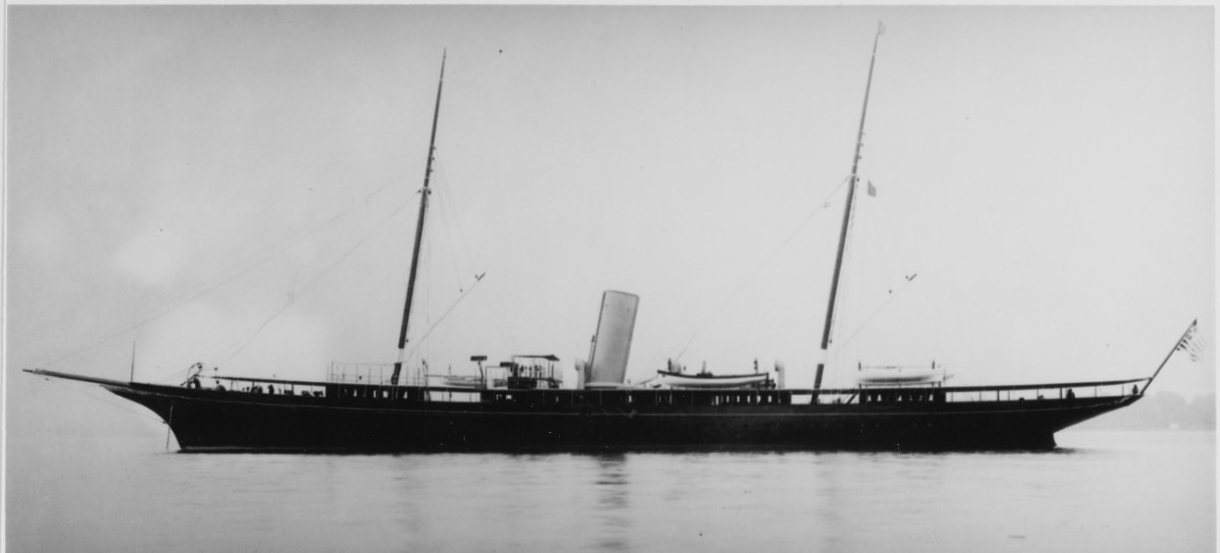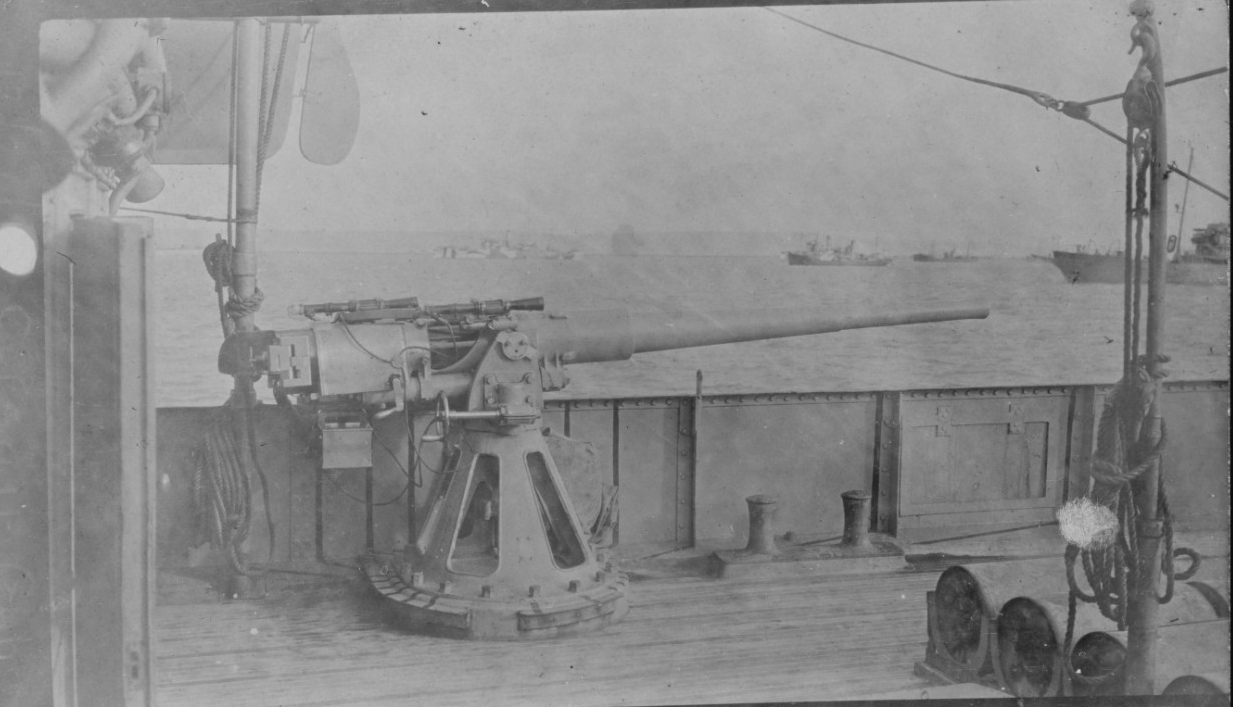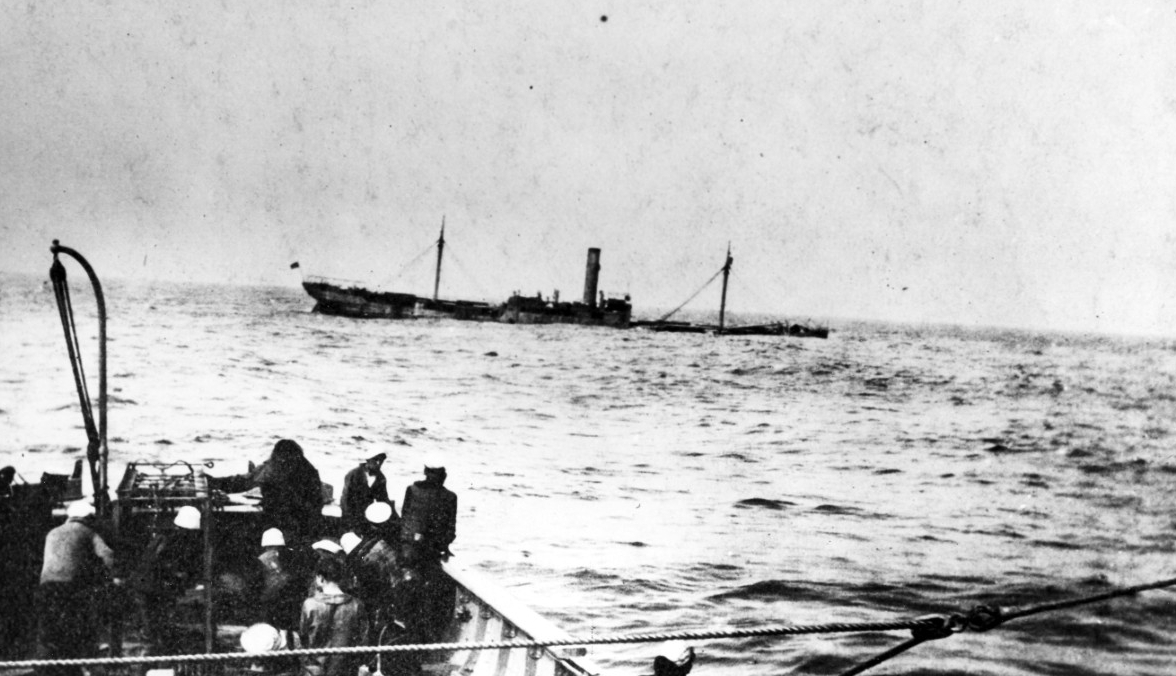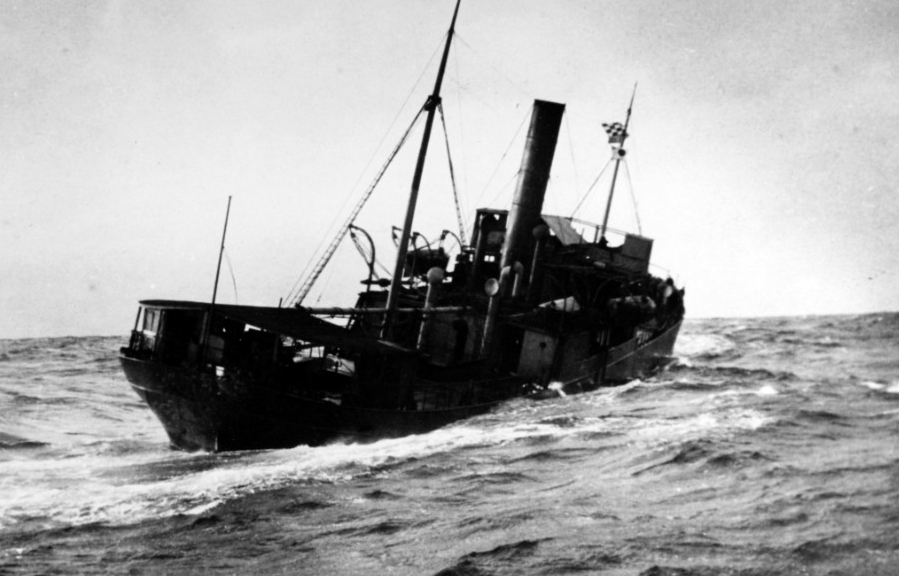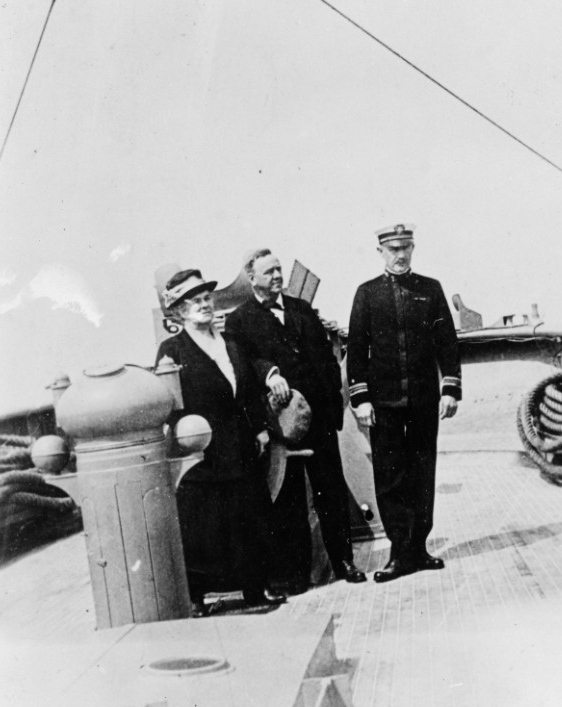Corsair I (S. P. 159)
1917–1919
The first Corsair retained the name she carried at the time of her acquisition by the Navy.
I
(S. P. 159: displacement 1,600; length 304'; beam 33'4"; draft 16'; speed 19 knots; complement 123; armament 4 3-inch, 2 Colt machine guns)
Corsair, a steel hulled twin-screw steam yacht, was built in 1899 at Hoboken, N.J., by W. & A. Fletcher Co. for the noted financier J. Pierpont Morgan.
Amidst growing anticipation of hostilities, Corsair underwent a Navy inspection at Brooklyn, N.Y., on 1 March 1917; the U.S. declared war on Germany on 6 April. Corsair, at New York, N.Y., on 21 April 1917, was later assigned to Squadron Two, Patrol Force, on 9 May. Given the designation S. P. 159, Corsair was chartered by the Navy on 15 May 1917 from her owner, and commissioned at New York the same day, Lt. Cmdr. Theodore A. Kittinger in command.
The Navy Department ordered Capt. William B. Fletcher to assume command of eight armed yachts: Corsair, Aphrodite (S. P. 135), Harvard (S. P. 209), Sultana (S. P. 134), Christabel (S. P. 162), Kanawha II (S. P. 130), Vedette (S. P. 163), and Noma (S. P. 131) being fitted out for foreign service to be deployed to France as the U.S. Patrol Squadron Operating in European Waters (later U.S. Naval Forces Operating in French Waters). On 4 June 1917, Corsair and Aphrodite were ordered to report to Rear Adm. Albert Gleaves for temporary duty. She went to sea on 5 June, and returned to the New York Navy Yard, Brooklyn, N.Y., two days later and coaled-ship, taking on board 362 tons. She then shifted to Tompkinsville [Staten Island] (Base No. 21), N.Y., on 8 June and returned the same day to the Navy Yard to continue her fitting out.
Corsair sailed from New York on 14 June 1917 with the First American Expeditionary Force (AEF) convoy. Four groups sailed from New York bound for St. Nazaire, France. Group 1 consisted of Seattle (Armored Cruiser No. 11), Corsair, Wilkes (Destroyer No. 67), Terry (Destroyer No. 25), and Roe (Destroyer No. 24), the troop transport DeKalb (Id. No. 3010), and the troop transports USAT Tenadores, USAT Saratoga, USAT Havana, and USAT Pastores. The oilers Kanawha (Fuel Ship No. 13) and Maumee (Fuel Ship No. 14) preceded the convoy to refuel the destroyers at sea as required. Corsair was compelled to drop back, however, to accompany Aphrodite, so she joined the second group of the troop convoy. In the morning on 24 June at the scheduled rendezvous point, destroyers from Queenstown, Ireland (Base No. 6), sighted elements of the Group 1 AEF convoy and escorted them into St. Nazaire (Base No. 8), where they anchored on the 27th. Corsair and Aphrodite arrived with Group 2 later in the day and dropped anchor at St. Nazaire. On 2 July, she stood out from that port in company with Aphrodite, and shifted to Brest, France (Base No. 7), where she arrived on the 4th, to join the U.S. Patrol Squadrons operating against enemy submarines and performing escort and patrol duties off the west coast of France. Teamed with Aphrodite, the two yachts were designated Group D, Patrol Squadron, on 12 July. The squadron began active operations in conjunction with the French Navy two days later, on the 14th.
Corsair proceeded to sea with Aphrodite to relieve Noma and Kanawha II and shepherded the convoy into the Loire River, 28–30 July 1917. She later conducted tests of the Elia-Sperry depth charges and reported that they failed to explode; and subsequently evaluated the French depth charge known as a Grenade Guiraud on 21 August. Afterward, she went to St. Nazaire to refuel.
Corsair’s first reported contact with a German U-boat was while engaged in an escort mission in company with Harvard, 130 miles west of Ushant, France, on 2 September 1917. On 5 September, she rescued survivors from the French sailing vessel Sadi Carnot which had been sunk the preceding day by UC-69 (Oberleutnant zur See Hugo Thielmann, commanding). Corsair was dispatched from Brest on 14 September bound for Devonport, England, for munitions re-supply. Arriving that same day she underwent replenishment and returned to Brest on 18 September.
Later, while underway on 2 October 1917, Corsair, hearing gunfire, sighted a large submarine about 500 yards distant. She observed U-60 (Kapitänleutnant Karlgeorg Schuster) shelling the French barkentine Eugene Louise. Speeding to her location, Corsair fired her No. 2 gun which struck astern of the U-boat. After several shots, U-60 submerged and the yacht passed over the site, dropping four depth charges. While all of them detonated, the explosions produced no certain result. She then picked up the survivors from the barkentine and brought them into port.
Corsair, in company with Aphrodite, Alcedo (S. P. 166), and Kanawha II, departed St. Nazaire on 15 October 1917 escorting USAT Antilles, Henderson (Troop Transport No. 1), and Willehad (Id. No. 1334). After stopping at Quiberon, France, the convoy steamed westward. On the 16th, a freshening wind kicked up a boisterous sea and Kanawha II found herself in trouble, taking water over her bows and flooding her decks. To avoid being seriously battered, she reduced speed, especially as the weather worsened.
The next day, the ships were zigzagging, with all lookouts properly kept and gunners at their stations. Antilles had her own battery manned by a Naval Armed Guard detachment. At 6:45 a.m., she was steaming directly astern of Corsair during one of the frequent changes of course. Henderson hoisted a signal just as Antilles had been hit and mortally wounded by a torpedo fired from U-105 (Kapitänleutnant Friedrich Strackerjan). Henderson immediately turned to starboard and lay a smoke screen, Willehad turned to port and passed very nearly over the U-boat. Alcedo turned back to the spot where the Antilles sank, while Corsair steamed at nineteen knots directly astern of Henderson, followed by Alcedo. The two escorting vessels continued in the vicinity of the wreckage until 8.30 a.m. but found no sign of U-105. Meanwhile, Alcedo picked up survivors while Corsair continued circling around the boats and wreckage. Corsair then assisted in picking up the survivors in outlying boats and patrolling the vicinity until 10.30 a.m. All survivors having been rescued, and it being impossible to overhaul either the Henderson or the Willehad before nightfall, the yachts set a course for Brest. In total, the yachts rescued all but 67 -- the greatest U.S. loss of life at sea to that point in the war -- of those on board Antilles. That same day, Vice Adm. Sims, Commander, U.S. Naval Forces Operating in European Waters designated a special division of yachts under command of Cmdr. Frederic N. Freeman to be used primarily for escort of convoys along the French coast. The division consisted of Aphrodite, Corsair, Alcedo, Wakiva II (S. P. 160), Noma, and Kanawha II.
After taking on fuel and provisions, Corsair departed St. Nazaire on 27 October 1917 escorting the transports Buford (Id. No. 3818), City of Savannah (Id. No. 4514), and Finland (Id. No. 4543). The U.S. escorting forces based in France had been recently been bolstered by a contingent of coal-burning destroyers previously stationed at Ponta Delgada, Azores (Base No. 13). Of these, Lamson (Destroyer No. 18), Flusser (Destroyer No. 18), Preston (Destroyer No. 18), and Smith (Destroyer No. 18) along with the yachts Alcedo and Wakiva II, would serve as the convoy escort. Corsair, with Cmdr. Freeman, the escort commander, embarked, led the column, with a destroyer on each bow of Finland, Alcedo to starboard of Buford, Wakiva II to port, and a destroyer hovering on each quarter of City of Savannah.
There had been no expectation of danger aside from the routine warning contained in the force orders: “Enemy submarines operating in war zone as usual.” At 9.25 a.m., one day out from port, on 28 October, Finland was struck by a torpedo on the starboard side from U-93 (Kapitänleutnant Helmut Gerlach). Again there was no sign of a submarine. This time, however, Corsair heard the explosion and saw a huge column of water spout up against the ship. Finland, however, merely slowed down, then halted, releasing steam. As seen from Corsair, she rode on an even keel despite the 35-foot hole torn in her side. On board Finland were many Antilles survivors who raced to abandon ship. When Cmdr. Freeman, realized that Finland was not sinking, however, he semaphored the message “Do you think you can make Saint-Nazaire?" The answer came right back from Finland's skipper: ''Why not New York?''
Corsair cracked on speed to search for the submarine, instructing Wakiva II and Alcedo to aid Finland’s people who were adrift in boats or upon rafts. Three destroyers proceeded on the voyage with the two other transports while Smith remained with Corsair. Finland was able to move under her own steam and the task in hand was to put the crew back on board and escort her into Brest for repairs. Meanwhile, Corsair released a barrage of 11 depth charges over her stern, jarring her rivets, but with no results. The stricken Finland ploughed along at fifteen knots while Corsair and Smith hovered close until they saw Ushant Light. Before midnight, Finland had passed through the Raz de Sein and lay safely anchored in Morgat Bay. The next morning, having entered Brest Harbor, Finland, Smith, and Corsair rested at the mooring buoys. Finland eventually entered dry dock in France, while Corsair returned to her escort duties.
During the following month, Corsair and four destroyers rendezvoused with an inbound convoy and escorted it without incident into St. Nazaire on 6 November 1917. She then joined a convoy forming at Quiberon on 8 November. The convoy, consisting of the transports DeKalb, Tenadores, Pastores, and USAT Henry R. Mallory and escorted by Corsair, Smith, Lamson, and Flusser, departed later that afternoon. After two days underway, the escort parted company with the transports and returned to their French bases. Corsair, in company with four destroyers, on 21 November, was returning to Brest, while enroute, the ships conducted depth charge exercises. On 30 November, Corsair, along with Preston and French destroyers, left Brest at 6:30 a.m., convoying twenty merchant vessels southward to points along the coast. She stood back into Brest on 2 December. She was underway again on 15 December departing for a convoy at 2:20 p.m. During this deployment, Corsair was caught in a heavy gale. Badly damaged, she was required to seek refuge in Portuguese waters. She was later dispatched to Lisbon, Portugal, where she arrived on 19 December, and underwent repairs primarily to her forward deckhouse.
Corsair, with her repairs complete, departed on 27 January 1918 and reported back to Brest, the next day. Between 31 January and 19 February 1918, the converted yachts Corsair, Noma, Wakiva II, May (S. P. 164), Nokomis (S. P. 609), and Aphrodite, were sent to a new base at Rochefort, France (Base No. 20). The reasons that these vessels were not sent simultaneously as some were undergoing repairs incident to their continuous service since their arrival in Europe and others could not be immediately be spared. Corsair arrived and moored at Pauillac, France on 1 February. She remained there until the 10th, when she got underway to escort a convoy and upon completion of that mission, arrived at Rochefort on 13 February.
Corsair, steamed westward from Verdon in company with Wakiva II and Aphrodite, on 5 May 1918 to rendezvous with Convoy HB-01 and escort it into the French coast. The following month, in the conduct of her escort duties on 22 June 1918, she made a vain attempt to tow the disabled ship Californian, which had struck a mine in the Bay of Biscay. The yacht did, however, rescue the survivors and brought them into port. Californian went down by the head and sank. The yacht would spend the remainder of the war operating from her base on the Gironde River.
Corsair, on 4 August 1918, joined by May and Noma, along with the French ships Etourdi, Alberte, Vaillante, and Cassiopée (Capitaine de Corvette Douguet commanding) conveyed a convoy to its westernmost boundary, the escorts then parted with their charges on 7-8 August and May, Noma, and Cassiopée steamed eastward to overtake an inbound convoy. Aphrodite and Corsair did likewise, to meet their assigned inbound convoy. Having escorted the convoy into port, Corsair met a convoy of 30 tramp steamers bound for the U.S., with Reid (Destroyer No. 21) and Aphrodite and Noma on 13 August 1918. The following month, Corsair added to her outstanding rescue record when she was ordered to stand by the disabled Norwegian steamer Dagfin on 10 September. She eventually towed her into Verdon, France, on 14 September. Vice Adm. Henry B. Wilson, Commander, U.S. Naval Forces in France, took pleasure in commending “the excellent seamanship and judgment displayed” by Lt. Cmdr. William B. Porter, USNRF, the ship’s commanding officer, in the salvage of Dagfin.
With hostilities having ended with the Armistice of 11 November 1918, Secretary of the Navy Josephus Daniels wired Vice Adm. Sims on 12 November to inform him that the yachts Aphrodite, Corsair, Cythera (S. P. 575), Noma, Rambler (S. P. 211), Sultana (S. P. 134), Vedette (S. P. 163), Harvard (S. P. 209), and Piqua (formerly Kanawha II), were free of their leases and should be returned to the U.S. as soon as practicable. Corsair cleared Brest on 18 November 1918, for operations in British waters, calling at Rosyth, Scotland with the expectation of becoming the flagship for Rear Adm. Samuel S. Robison’s inspection tour of the German ships at Kiel, Germany. That did not occur, so she reported to Queenstown, Ireland (Base No. 6), to relieve Melville (Destroyer Tender No. 2), flagship for Commander, U.S. Naval Forces in European Waters on 26 December. The flag was shifted from Melville on 4 January 1919. She, however, had not been formally detached from Commander, U.S. Naval Forces in France; this was done officially on 14 January. The yacht received orders on 27 March stating that she was to return to the United States upon her relief at Plymouth, England. Corsair later put in to Plymouth on 7 May to embark Secretary of the Navy Daniels and his staff for transportation to Brest in company with Conner (Destroyer No. 72), sailing with them on 8 May and arriving the same day. The dignitaries disembarked on 9 May.
Corsair set course for for New York on 10 May 1919. Proceeding by way of Ponta Delgada, Azores, on 14 May, and Bermuda (Base No. 24) on 25 May, she arrived at her destination on 28 May. She was placed out of commission on 9 June 1919 and returned to her owner at New York.
Having returned to service as a luxury yacht for J. P. Morgan, Jr. until 2 January 1930, the yacht was donated by Morgan to the U.S. Coast and Geodetic Survey with the stipulation that she be engaged in survey work. Renamed and designated as Oceanographer, she was classified as an ocean survey ship. She operated along the Atlantic Coast during her career with the USCGS.
Oceanographer was acquired by the Navy from the Coast and Geodetic Survey at Norfolk, Va., on 7 April 1942, classified initially as a gunboat and briefly renamed Natchez (PG-85) (April-May); she was renamed Oceanographer (AGS-3); re-rigged and outfitted at Norfolk Shipbuilding and Drydock Co. for survey duty; and commissioned on 15 August. Work was completed on 28 August, and Cmdr. Henry B. Campbell, USCGS, assumed command.
After her shakedown in the Chesapeake Bay, Oceanographer steamed for New York on 3 October 1942, to join a convoy en route to Cristóbal, C.Z. She transited the Panama Canal, and at San Pedro, Calif., reported for duty to Commander in Chief, Pacific Fleet (CinCPac). Upon completion of repairs at San Pedro, she got underway for Seattle, Wash. She encountered a severe storm off Astoria, Ore., necessitating further repairs at Winslow Marine Railway Co., Bainbridge Island, Wash. Proceeding to Kodiak, Alaskan Territory, via the Inside Passage, she reported to the Alaskan Command with no sound or radar gear, a very short cruising radius, and limited potable water capabilities. As such, she was considered generally unsuitable for Aleutian duty.
Oceanographer returned to Seattle, on 25 December 1942 for additional repairs. After towing a lighter from Seattle to San Francisco, she received orders dispatching her to the Matson Navigation Co. for repairs. Cmdr. Myron W. Graybill, her executive officer, assumed command on 2 March 1943 and the following day Oceanographer got underway for Pearl Harbor, where she underwent the installation of sound gear and other necessary alterations.
The survey ship departed Pearl Harbor escorting several LSTs and plotted a course for Nouméa, New Caledonia. As her first war zone assignment, she surveyed the Havannah Passage, New Caledonia. Upon completion of the passage charts, the ship made three additional surveys in the vicinity of Nouméa and erected aids to navigation to facilitate increased marine safety. On 1 November 1943, she proceeded to Guadalcanal via Espiritu Santo to produce charts of that island’s northern coast. She also surveyed Munda Bar and the neighboring anchorages at Munda, New Georgia, British Solomon Islands. At various times, submarine chasers (PC) and coastal transports (APc) assisted in the surveys and dispatched triangulation parties to islands in the vicinity. During her sixteen months in the South Pacific, Oceanographer produced fifteen charts, each requiring as many as three million soundings and compiled accurate data for the area, the first for many of those locations.
Ordered to Pearl Harbor on 3 June 1944 for badly needed repairs, she was sent on to San Pedro, Calif., on 27 June. Upon completion of arrival inspection, it was decided to decommission and scrap her. Oceanographer was decommissioned on 22 September and was stricken from the Navy list on 14 October. In accordance with the agreement executed with J. Pierpont Morgan, Jr., she was broken up for scrap.
| Commanding Officers | Date Assumed Command |
| Lt. Cmdr. Theodore A. Kittinger | 15 May 1917 |
| Lt. Cmdr. William B. Porter, USNRF | 31 May 1918 |
| Cmdr. Henry B. Campbell, USCGS | 15 August 1942 |
| Cmdr. Myron W. Graybill | 2 March 1943 |
Christopher B. Havern Sr.; Commanding Officers List compiled in conjunction with Thomas Biggs.
28 February 2020

